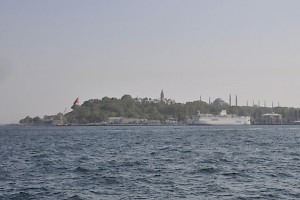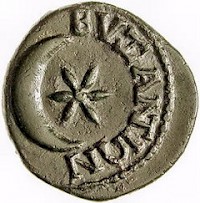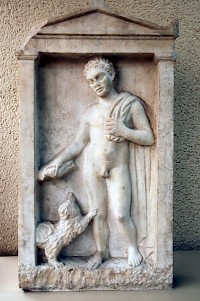Greek Byzantium
Q16869Constantinople (Κωνσταντινούπολις) or Byzantium (Βυζάντιον): Greek city on the Bosphorus, capital of the Byzantine Empire, modern İstanbul.

According to a legend, told by the Roman historian Tacitus, the god of Delphi ordered the Megarans to build a city "opposite the land of the blind".note This referred to the inhabitants of Chalcedon, who had founded their city east of the Bosphorus, whereas the western side is a much better place. A similar story is told by the Greek researcher Herodotus of Halicarnassus, who attributes the remark about the blindness of the Chalcedonians to the Persian commander Megabazus.note Tacitus adds that catching fish was especially easy at the place where Byzantium was to be built, and explains that this was one of the sources of Byzantine wealth. Another advantage was the Golden Horn (Chrysokeras), a deep inlet that offers excellent protection to the city: an army can only approach it from the west.
The founder of the city was, reportedly, a man named Byzas, who in 658 BCE came from Megara with settlers from his own town, supplemented with people from Corinth, Argos, and Boeotia. While the provenience of the settlers cannot be confirmed, the fact that Megara was the mother city can be corroborated: the names of the Byzantine institutions, months, and phylai are identical to those of Megara.
The city became part of the Achaemenid Empire in c.513, when king Darius I the Great crossed to Europe. The temporary bridge that he built, at the place of the modern Fath Sultan Mehmet bridge, was an important monument, and the columns that decorated it, were later brought to Byzantium, where Herodotus saw them in the shrines of Dionysus and Artemis.note
After the Persian Wars (490, 480-479), Byzantium became a democratic town and a member of Athens' Delian League, to which it paid a high tribute - an indication of the city's prosperity. The city was loyal, and this was important: Athens was a big city that needed to import grain from the Black Sea, so control of the Bosphorus was imperative. However, during the second half of the Peloponnesian War, which is usually called the Decelean or Ionian War, Byzantium switched sides (411). The Spartan governor Clearchus and his garrison were outwitted by the Athenian leader Alcibiades and the city became Athenian again in 408, but remained vulnerable. When the Spartan admiral Lysander threatened to attack Byzantium in 405, the Athenians were sufficiently alarmed to fight a battle with him in the Hellespont at Aigospotamoi, which they lost. From now on, Byzantium was pro-Sparta again, and the food supply of Athens was cut off. The city that had once been master of the Aegaean world surrendered to Sparta in April 404 and its alliance was dissolved.

In the fourth century, the Delian League was restored, and Byzantium joined the Athenian alliance again, until the Social War (357-355), which meant the final end of Athens' hegemony. The power vacuum was filled by king Philip II of Macedonia, who laid siege to Byzantium and nearby Perinthus in 340, but backed off when the Achaemenid Empire energetically intervened by sending armies to Europe again. The Byzantines believed they had received divine help from Hecate, and started to use her symbols on their coins: a star and a crescent moon - an icon that is still in use in Turkey.
Byzantium appears to have been an important cultural center; at least, we know the names of several authors, something that we do not know for the preceding or following centuries. Well-known were the tragedian Homer, the engineer Philo, and the astrologer Epigenes. The inhabitants were sometimes portrayed as decadent - for instance, in his comedy The Flute Girl, Menander puts a Byzantine merchant on the stage who boasts to be drunk all day.
Byzantium retained some of its independence in the Hellenistic age, although it paid tribute to Galatian tribes moving from Europe to Asia. When the Byzantines tried to compensate themselves by demanding money from those who were sailing through the Bosphorus, Rhodes declared war in 220; Byzantium was forced to give in.note Still, the Romans will have been grateful when Byzantium sided with them. This was the beginning of a long tradition of cooperation.note.

For a city that is still inhabited, we know quite a lot about the topography of Byzantium. A visitor would have seen two important ports along the Golden Horn: the Prosphorion port in the area of the modern Sirkeci railroad station, and the Neorion port, a bit further to the west, in the area of the modern Galata bridge. Next to the Prosphorion, there were shrines dedicated to the deities of Eleusis, and to Achilles and Ajax. The Strategeion was also in this area. On the Acropolis (modern Topkapı), the gods Dionysus, Poseidon, Athena, Artemis, and Aphrodite had their temples - the last one being almost identical to the current church of the Divine Peace.
A bit more to the south, there was a big square, surrounded by four porticoes and consequently called Tetrastôn, "four stoa square". It has survived the centuries: it was later renamed Augusteôn, and is now known as Sultanahmet Meydanı. In the neighborhood, one could find a sanctuary of Tyche and Rhea, and in the area of the future hippodrome, Hecate was venerated.